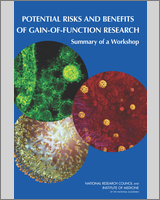NCBI Bookshelf. A service of the National Library of Medicine, National Institutes of Health.
On October 17, 2014, spurred by incidents at U.S. government laboratories that raised serious biosafety concerns, the United States government launched a one-year deliberative process to address the continuing controversy surrounding so-called “gain-of-function” (GOF) research on respiratory pathogens with pandemic potential. The gain of function controversy began in late 2011 with the question of whether to publish the results of two experiments involving H5N1 avian influenza and continued to focus on certain research with highly pathogenic avian influenza over the next three years. The heart of the U.S. process is an evaluation of the potential risks and benefits of certain types of GOF experiments with influenza, SARS, and MERS viruses that would inform the development and adoption of a new U.S. Government policy governing the funding and conduct of GOF research.
Potential Risks and Benefits of Gain-of-Function Research is the summary of a two-day public symposia on GOF research. Convened in December 2014 by the Institute of Medicine and the National Research Council, the main focus of this event was to discuss principles important for, and key considerations in, the design of risk and benefit assessments of GOF research. Participants examined the underlying scientific and technical questions that are the source of current discussion and debate over GOF research involving pathogens with pandemic potential. This report is a record of the presentations and discussion of the meeting.
Contents
- THE NATIONAL ACADEMIES
- COMMITTEE ON GAIN-OF-FUNCTION RESEARCH WITH H5N1/H7N9 AVIAN INFLUENZA: A SYMPOSIUM
- BOARD ON LIFE SCIENCES
- COMMITTEE ON SCIENCE, TECHNOLOGY, AND LAW
- BOARD ON HEALTH SCIENCES POLICY
- Acknowledgments
- 1. Introduction
- 2. Assessing Risks and Benefits
- 3. Gain-of-Function Research: Background and Alternatives
- 4. Potential Benefits of Gain-of-Function Research
- 5. Potential Risks: Biosafety and Biosecurity
- 6. Policy Implications
- References
- APPENDIXES
Rapporteurs: Frances Sharples, Jo Husbands, Anne-Marie Mazza, Audrey Thevenon, and India Hook-Barnard.
This study was supported by Contract No. 10002374 between the National Academy of Sciences and the National Institutes of Health, by the John D. and Catherine T. MacArthur Foundation, the Alfred P. Sloan Foundation, the Wellcome Trust, and by internal support from the National Academies. Any opinions, findings, conclusions, or recommendations expressed in this publication are those of the author(s) and do not necessarily reflect the views of the organizations or agencies that provided support for the project.
NOTICE: The project that is the subject of this report was approved by the Governing Board of the National Research Council, whose members are drawn from the councils of the National Academy of Sciences, the National Academy of Engineering, and the Institute of Medicine. The members of the committee responsible for the report were chosen for their special competences and with regard for appropriate balance.
- NLM CatalogRelated NLM Catalog Entries
- Gain-of-Function Research: Ethical Analysis.[Sci Eng Ethics. 2016]Gain-of-Function Research: Ethical Analysis.Selgelid MJ. Sci Eng Ethics. 2016 Aug; 22(4):923-964. Epub 2016 Aug 8.
- Review Gain-of-Function Research: Summary of the Second Symposium, March 10-11, 2016[ 2016]Review Gain-of-Function Research: Summary of the Second Symposium, March 10-11, 2016Board on Life Sciences, Division on Earth and Life Studies, Board on Health Sciences Policy, Health and Medicine Division, Committee on Science, Technology, and Law, Policy and Global Affairs, National Academies of Sciences, Engineering, and Medicine. 2016 Jun 20
- Comparison of International Guidance for Biosafety Regarding Work Conducted at Biosafety Level 3 (BSL-3) and Gain-of-Function (GOF) Experiments.[Appl Biosaf. 2016]Comparison of International Guidance for Biosafety Regarding Work Conducted at Biosafety Level 3 (BSL-3) and Gain-of-Function (GOF) Experiments.Johnson B, Casagrande R. Appl Biosaf. 2016 Sep 1; 21(3):128-141. Epub 2016 Sep 1.
- Biosafety Recommendations for Work with Influenza Viruses Containing a Hemagglutinin from the A/goose/Guangdong/1/96 Lineage.[MMWR Recomm Rep. 2013]Biosafety Recommendations for Work with Influenza Viruses Containing a Hemagglutinin from the A/goose/Guangdong/1/96 Lineage.Centers for Disease Control and Prevention, Gangadharan D, Smith J, Weyant R. MMWR Recomm Rep. 2013 Jun 28; 62(RR-06):1-7.
- Review Gain-of-function experiments: time for a real debate.[Nat Rev Microbiol. 2015]Review Gain-of-function experiments: time for a real debate.Duprex WP, Fouchier RA, Imperiale MJ, Lipsitch M, Relman DA. Nat Rev Microbiol. 2015 Jan; 13(1):58-64. Epub 2014 Dec 8.
- Potential Risks and Benefits of Gain-of-Function ResearchPotential Risks and Benefits of Gain-of-Function Research
Your browsing activity is empty.
Activity recording is turned off.
See more...
